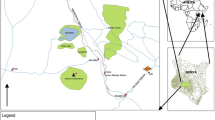Abstract
The level of concentrations of polycyclic aromatic hydrocarbons (PAHs) in surface soils from petroleum handling facilities (kerosene tank, generating plant, petrol stations, mechanic workshops, leaking pipeline and air port fuel dump) from Calabar metropolis southeastern Nigeria was determined by gas chromatography/ mass spectrometry. The results show that total polycyclic aromatic hydrocarbons (PAHs) varied from 1.80 to 334.43 mg/kg with a mean of 50.31 mg/kg. The lowest value of 1.80 mg/kg was obtained from petrol station while the highest value of 334.43 mg/kg was obtained from facility characterised by petrol stations and mechanic workshops. The ratio of phenanthrene/anthracene and fluoranthene/pyrene, varied from 0.43 to 27.72 and from 0.14 to 17.76 respectively. These ratios indicate various sources for the PAH. The two to three ring PAHs are the most abundant. Based on the PAH ratios and content alone it is not possible to distinguish between contribution from motor vehicle exhaust, gasoline spillage, used engine oil or petroleum production. However, considering the area of the study, it is very likely that the major source of soil contamination is originating from petroleum product.
Similar content being viewed by others
References
Agency for Toxic Substances and Disease Registry (ASTDR) (1995). Toxicological profile for polycyclic aromatic hydrocarbons (PAHs) (Update). US Department of Health and Human Services. Agency for Toxic Substances and Disease Registry, Atlanta, Georgia, 458.
Benner, B. A., Bryner, N. P., Wise, S. A., Muholland, G. H., Lao, R. C., & Fingas, M. F. (1990). Polycyclic aromatic hydrocarbons emissions from combustion of crude oil on water. Environmental Science & Technology, 24, 1418–1427.
Benner, B. A., Gordon, G. E., & Wise, S. A. (1989). Mobile sources of atmospheric polycyclic aromatic hydrocarbons: A roadway tunnel study. Environmental Science & Technology, 23, 1269–1278.
Bernes, C. (1996). Persistent organic pollutants. A Swedish view of an international problem. Swedish environmental protection agency, Sweden, 26.
Budzinski, H., Jones, I., Bellocq, J., Pierard, C., & Garrigues, P. (1997). Evaluation of sediment contamination by polycyclic aromatic hydrocarbons in the Gironde estuary. Marine Chemistry, 58, 85–97.
Colombo, J. C., Pelletier, E., Brochu, C., Khalil, M., & Catoggio, J. A. (1989). Determination of hydrocarbon sources using n-alkanes and polycyclic aromatic hydrocarbon indexes. Environmental Science & Technology, 23, 888–894.
Edwards, N. T. J. (1983). Polycyclic aromatic hydrocarbons (PAHs) in the terrestrial environment – A review. Journal of Environmental Quality, 12, 427–441.
Gschwend, P. M., & Hites, R. A. (1981). Fluxes of the polycyclic aromatic hydrocarbons to marine and lacustrine sediments in the Northeastern United States. Geochimica et Cosmochimica Acta, 45, 2359–2367.
IARC (1983). Polynuclear aromatic compounds. Part 1 Chemical, environmental and experimented data, in IARC monographs on the evaluation of the carcinogeric risk of chemicals to humans, vol. 32. World Health Organisation International.
Ineson, J. (1973). The significance of oil pollution in the water resources field. In: J. I. Waddington & P. Hepple (Eds.), Water pollution by oil (pp. 143–152). England: Applied Science Publishers.
Iloeje, N. P. (1991). A new geography of Nigeria (p. 131). Nigeria: Longman.
Jones, K. C., Stratford, J. A., Waterhouse, K. S., Furlong, E. T., Giger, Hites, R. A., et al. (1989). Increase in the polynuclear aromatic hydrocarbon content of an agricultural soil over the last century. Environmental Science & Technology, 23, 95–101.
Krauss, M., Wilcke, W., & Zech, W. (2000). Polycyclic aromatic hydrocarbons and polychlorinated biphenyls in forest soils; depth distribution as indicator of different fate. Environmental Pollution, 110, 79–88.
Liu, M., Hou, L. J., Yang, Y., Zou, H. X., Lu, J. H., & Wang, X. R. (2001). Distribution and sources of polycyclic aromatic hydrocarbons in intertidal flat surface sediments from the Yangtze estuary, China. Environmental Geology, 4(11), 90–95.
Menzie, C. A., Potocki, B. B., & Santodonato (1992). Exposure to carcinogenic PAHs in the environment. Environmental Science & Technology, 26, 1278–1284.
Rippen, G. (1992). Handbuch Umweltchemikalien. Stoffdaten, Prufeverfuhren Vorschriften. EcomedVerlag, Landshut, Germany, 16 Erganzungslieferung.
Sicre, M. A., Marty, J. C., Saliot, A., Aparico, X., Grimalt, J., & Albaiges, J. (1987). Aliphatic & aromatic hydrocarbons in different sized aerosols over the Mediterranean Sea: occurrences & origin. Atmospheric Environment, 21, 2247–2259.
Sims, R. C., & Overcash, M. R. (1983). Fate of polynuclear aromatic compounds (PNAs) in soil plant systems. Research Review, 88, 2–68.
Smith, D. J. T., Edelhauser, E. C., & Harrison, R. M. (1995). Polynuclear aromatic hydrocarbon concentrations in road dust and soil samples collected in the United kingdom and Pakistan. Environmental Science & Technology, 16, 45–53.
Soclo, H. H., Garrigues, P. H., & Ewald, M. (2000). Origin of polycyclic aromatic hydrocarbons (PAHs) in coastal marine sediments, case studies in Cotonou, (Benin Republic) and Aquitaine (France) areas. Marine Pollution Bulletin, 40, 387–396.
Sporstol, J., Gjos, N., Litchtenthaler, R. G., Gustavsen, K O., Udral., K., & Oreld, I. (1983). Source identification of aromatic hydrocarbons in sediments using GC-Ms. Environmental Science & Technology, 17, 282–286.
Tebaay, R. H., Welp, G., & Brummer, G. W. (1983). Gehalte an polyzyklischen aromatischen kohlenwasserstoffen (PAK) and deren Verteilungsmuster. In unterschledlich belasteten Boden. Z. Pfianzenernaehr, Bodenk, 156, 1–10.
Wakeham, S. G. (1977). Synchronous fluorescence spectroscopy and it’s application to indigenous and petroleum-derived hydrocarbons in Lacustrine sediments. Environmental Science & Technology, 11, 272–276.
Walkley, A., & Black, C. A. (1934). An examination of the degtiareff method of determining soil organic matter and a proposed modification of the chromic acid and titration method. Soil Science, 37, 27–38.
Wilcke, W., Muller, S., Kanchanakool, N., & Zech, W. (1998). Urban soil contamination in Bangkok: heavy metal and aluminium partitioning in top soils. Geoderma, 86, 211–228.
Wilcke, W., Muller, S., Kanchanakool, C. N., & Zech, W. (1999). Polycyclic aromatic hydrocarbons in hydromorphic soils of the tropical metropolis Bangkok. Geoderma, 91, 297–309.
Wise, S. A., Benner, B. A., Byrd, C. D., Chesler, S. N., Rebbert, R. E., & Schantz, M. M. (1988). Determination of polycyclic aromatic hydrocarbons in a coal tar standard reference material. Analytical Chemistry, 60, 887–894.
Yang, G.-P. (2000). Polycyclic aromatic hydrocarbons in the sediments of the South China Sea. Environmental Pollution, 108, 163–171.
Yang, S. Y. N., Connell, D. W., Hawker, D. W., & Kayal, S. I. (1991). Polycyclic aromatic hydrocarbons in air, soil, and vegetation in the vincinity of an urban roadway. Science of the Total Environment, 102, 229–240.
Yang, G.-P., Liu, X. L., & Zhang, J. W. (1998). Distribution of dibenzothiophene in the sediments of the South China Sea. Environmental Pollution, 101, 405–414.
Youngblood, W. W., & Blumer, M. (1975). Polycyclic aromatic hydrocarbons in the environment; Homoogous series in soils and recent marine sediments. Geochimica et Cosmochimica Acta, 39, 1303–1314.
Author information
Authors and Affiliations
Corresponding author
Rights and permissions
About this article
Cite this article
Nganje, T.N., Edet, A.E. & Ekwere, S.J. Distribution of PAHs in Surface Soils from Petroleum Handling Facilities in Calabar. Environ Monit Assess 130, 27–34 (2007). https://doi.org/10.1007/s10661-006-9453-9
Received:
Accepted:
Published:
Issue Date:
DOI: https://doi.org/10.1007/s10661-006-9453-9




